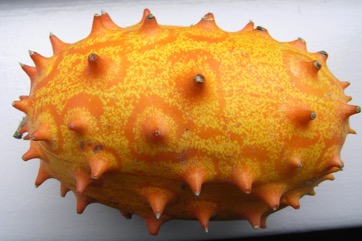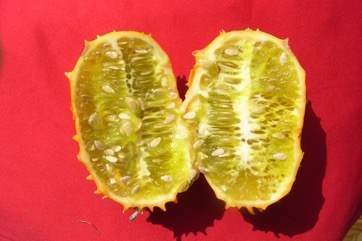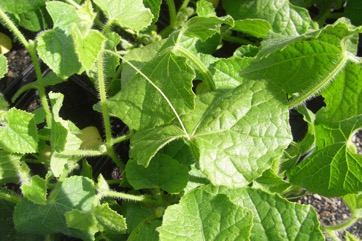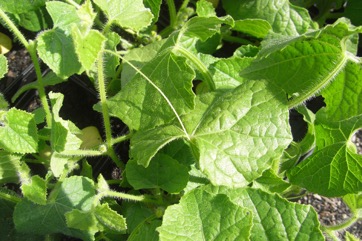African Horned cucumber, Kiwano

A tropical plant. It requires conditions similar to cucumbers. It prefers light well drained soil. It needs a protected sunny position. It is drought and frost tender. It grows at low and medium elevations in Zimbabwe. It grows between 210-1,800 m above sea level. It can grow in arid places.
Also known as:
African horned melon, Afriška bučka, Chicuachavate, Chicuapuruto, Gaka, Gakachika, Hedged gourd, Horned melon, Jelly melon, Kangamkhwani, Magabala, Melano, Mokapana, Mugagachiga, Mugaika, Mugaka, Mugamganam, Mugumudsambwa, Mukake, Mushonja, Mutete, Nku, Okuju, Uhufafa, Umhlagahlaga
Synonyms
- Cucumis tinneanus Kotschy & Peyr. The correct spelling in probably now metulifer
Edible Portion
- Fruit, Seeds, Vegetable, Leaves
Where does African Horned cucumber grow?
Found in: Africa, Australia, Angola, Botswana, Brazil, Burkina Faso, Cameroon, Central Africa, Central African Republic, CAR, Congo, Congo DR, Cook Islands, East Africa, Eswatini, Ethiopia, France, Gambia, Guinea, Guinée, Israel, Kenya, Liberia, Malawi, Marquesas, Mozambique, Namibia, New Zealand, Nigeria, North America, Sao Tome and Principe, Senegal, Sierra Leone, Slovenia, Somalia, South Africa, Southern Africa, South America, Sudan, Swaziland, Tanzania, Uganda, United States, West Africa, Yemen, Zambia, Zimbabwe
Notes: There are about 25 Cucumis species.
Status: It is a commercially cultivated vegetable. Fruit are sold in local markets. Improved varieties have been produced.
Growing African Horned cucumber, Kiwano
Cultivation: Plants are grown from seed. They take 8-16 days to germinate in warm soil.
Edible Uses: The peeled fruit are eaten raw. They can also be cut open and sun dried for storage and use in preserves. The young leaves are stripped and cooked then eaten. The seeds are pounded and used for flavouring. CAUTION: If the plants are bitter they need to be used with caution.
Production: Plants grow rapidly. They flower and set fruit in 6-8 weeks. It is then 7 weeks to maturity.
Nutrition Info
per 100g edible portion| Edible Part | Energy (kcal) | Protein (g) | Iron (mg) | Vitamin A (ug) | Vitamin c (mg) | Zinc (mg) | % Water |
|---|---|---|---|---|---|---|---|
| Fruit | 33 | 1.1 | 0.5 | - | 18.6 | 0.3 | 91 |
African Horned cucumber, Kiwano Photos




References
Ann. Sci. Nat. Bot. ser. 4, 11:10. 1859
Anywar, G., et al, 2014, Wild Plants Used as Nutraceuticals from Nebbi District, Uganda. European Journal of medicinal Plants. 4(6):641-660
Bodkin, F., 1991, Encyclopedia Botanica. Cornstalk publishing, p 305
Burkill, H. M., 1985, The useful plants of west tropical Africa, Vol. 1. Kew.
Cooper, W. and Cooper, W., 2004, Fruits of the Australian Tropical Rainforest. Nokomis Editions, Victoria, Australia. p 140
Dalziel, J. M., 1937, The Useful plants of west tropical Africa. Crown Agents for the Colonies London.
Djihounouck, Y., et al, 2018, Diversité Et Importance Socio-Economique Des Espèces Fruitières Sauvages Comestibles En Zone Kasa (Sud-Ouest Du Sénégal). European Scientific Journal December 2018 edition Vol.14, No.36 ISSN: 1857 – 7881
Flora of Australia, Volume 8, Lecythidales to Batales, Australian Government Publishing Service, Canberra (1982) p 190
Fowler, D. G., 2007, Zambian Plants: Their Vernacular Names and Uses. Kew. p 22
Fox, F. W. & Young, M. E. N., 1982, Food from the Veld. Delta Books. p 171
Grivetti, L. E., 1980, Agricultural development: present and potential role of edible wild plants. Part 2: Sub-Saharan Africa, Report to the Department of State Agency for International Development. p 70
Grubben, G. J. H. and Denton, O. A. (eds), 2004, Plant Resources of Tropical Africa 2. Vegetables. PROTA, Wageningen, Netherlands. p 248
INFOODS:FAO/INFOODS Databases
Jardin, C., 1970, List of Foods Used In Africa, FAO Nutrition Information Document Series No 2.p 72
Kays, S. J., and Dias, J. C. S., 1995, Common Names of Commercially Cultivated Vegetables of the World in 15 languages. Economic Botany, Vol. 49, No. 2, pp. 115-152
Kiple, K.F. & Ornelas, K.C., (eds), 2000, The Cambridge World History of Food. CUP p 1796
Lazarides, M. & Hince, B., 1993, Handbook of Economic Plants of Australia, CSIRO. p 70
Leger, S., 1997, A Description of Today's Use of Plants in West Bushmanland (Namibia). German Development Service. PO Box 220035, 14061 Berlin, Germany. http://www.sigridleger.de/book/
Long, C., 2005, Swaziland's Flora - siSwati names and Uses http://www.sntc.org.sz/flora/
Lorenzi, H., Bacher, L., Lacerda, M. & Sartori, S., 2006, Brazilian Fruits & Cultivated Exotics. Sao Paulo, Instituto Plantarum de Estuados da Flora Ltda. p 397
Plowes, N. J. & Taylor, F. W., 1997, The Processing of Indigenous Fruits and other Wildfoods of Southern Africa. in Smartt, L. & Haq. (Eds) Domestication, Production and Utilization of New Crops. ICUC p 189
Lyle, S., 2006, Discovering fruit and nuts. Land Links. p 167
Maroyi, A., 2013, Use of weeds as traditional vegetables in Shurugwi District, Zimbabwe. Journal of Ethnobiology and Ethnomedicine 9:60
Maundu, P. et al, 1999, Traditional Food Plants of Kenya. National Museum of Kenya. 288p
Peters, C. R., O'Brien, E. M., and Drummond, R.B., 1992, Edible Wild plants of Sub-saharan Africa. Kew. p 101
Plants for a Future database, The Field, Penpol, Lostwithiel, Cornwall, PL22 0NG, UK. http://www.scs.leeds.ac.uk/pfaf/
Roodt, V., 1998, Common Wild Flowers of the Okavango Delta. Medicinal Uses and Nutritional value. The Shell Field Guide Series: Part 2. Shell Botswana. p 71
Royal Botanic Gardens, Kew (1999). Survey of Economic Plants for Arid and Semi-Arid Lands (SEPASAL) database. Published on the Internet; http://www.rbgkew.org.uk/ceb/sepasal/internet [Accessed 16th April 2011]
Ruiters-Welcome, A. K., 2019, Food plants of southern Africa. Ph.D. thesis. Univ. of Johannesburg p 49
Schneider, E., 2001, Vegetables from Amaranth to Zucchini: The essential reference. HarperCollins. p 345
Shava, S., et al, 2009, Traditional food crops as a source of community resilience in Zimbabwe. International Journal of the African Renaissance 4(1)
Silberbauer, 1965, 1972, 1981,
Swaziland's Flora Database http://www.sntc.org.sz/flora
Tredgold, M.H., 1986, Food Plants of Zimbabwe. Mambo Press. p 4
USDA, ARS, National Genetic Resources Program. Germplasm Resources Information Network - (GRIN). [Online Database] National Germplasm Resources Laboratory, Beltsville, Maryland. Available: www.ars-grin.gov/cgi-bin/npgs/html/econ.pl (10 April 2000)
van Wyk, B., 2005, Food Plants of the World. An illustrated guide. Timber press. p 158
van Wyk, Be, & Gericke, N., 2007, People's plants. A Guide to Useful Plants of Southern Africa. Briza. p 40
van Wyk, B-E., 2011, The potential of South African plants in the development of new food and beverage products. South African Journal of Botany 77 (2011) 857–868
Wilkins-Ellert, M.H., 2004. Cucumis metuliferus E.Mey. ex Naudin. [Internet] Record from Protabase. Grubben, G.J.H. & Denton, O.A. (Editors). PROTA (Plant Resources of Tropical Africa), Wageningen, Netherlands. < http://database.prota.org/search.htm>. Accessed 15 October 2009.
Williamson, J., 2005, Useful Plants of Malawi. 3rd. Edition. Mdadzi Book Trust. p 86
www.zimbabweflora.co.zw 2011